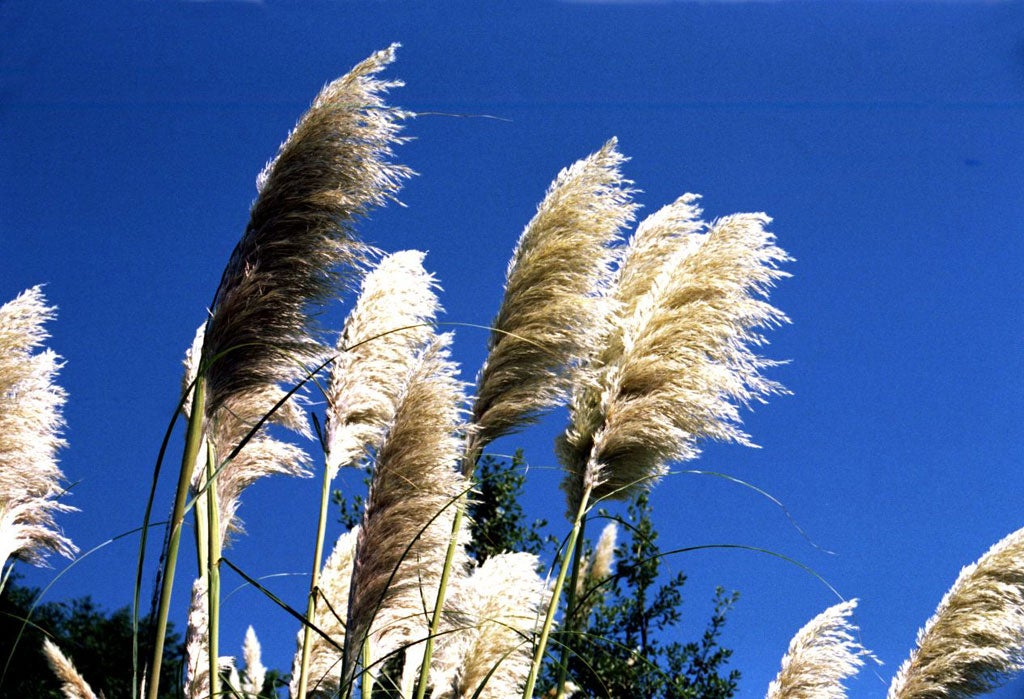Rockin' all over the world: South American pampas, that 1970s hit, is charting again

Poor old pampas grass. Somehow, in the era directly following The Good Life, it became the ultimate symbol of 1970s horticultural tackiness. (Rumours even circulated that planted in a front garden, it meant the residents were swingers. You don't even want to think about it, really.) And since then, this grand grass has never returned to fashion, somehow failing to follow other, more seductive 1970s revivals such as Led Zeppelin, George Smiley and cheese fondue.
Yes, pampas is the Status Quo of plants, destined never to be cool again. It stands outside the nursery window in the cold, looking in wistfully, eternally waiting for rehabilitation. Yet a stand of pampas, properly kept, is a magical thing. And perhaps "kept" is the wrong word anyway, because the pampas that have caught my eye this November seem to have flourished mainly through being left pretty much to their own devices.
Rather than the uptight, neat little tepee of stems dictated by garden style during the mid-1970s years of heatwaves and power cuts, this 21st-century pampas grass runs almost wild. Planted in a front garden, or on a municipal roundabout, they have spread sideways in the happy fashion of grasses. Instead of one bundle of stems, there are many, and their feathery heads strike a majestic chord of wild Argentina.
It's not just pampas looking lovely at the moment. All grasses are powerful elements of a November garden because their bleached, wheaten flower stems look so beautiful now, and will last as long as the weather allows. Instead of a garden that ends with autumn, grasses are lit by low winter light and frosted by morning ice, creating minimalist monotone fireworks. And each grass has its own style and shape, from the hedghoggy fronds of Pennisetum to the Art Nouveau arches of Miscanthus. Whether it's against hard urban skylines or soft country hedging, they bring the same joy to a pale, short day.
If you want to see grasses done best, you need to consult Neil Lucas of Knoll Gardens, whose stand at various flower shows is always one of great temptation, sucking people in with the irresistible force of the Death Star's tractor beam. And fortunately for all of us, he recently wrote a book on the subject, Designing with Grasses (Timber Press £20).
Lucas is having none of the pampas bullying. He refers to the plant more politely as Cortaderia selloana – but does advise taking care with its brutally sharp leaves. He sells three choice examples himself, but lists a dozen in his book, most of which have deliciously Argentinian-themed names. (Cortaderia "Evita", for example, is admired for not getting too leggy, and being covered in big fluffy feather-duster flowers.) Even if you really can't get your head round the swinging Argentinian, there's plenty else in the book to catch the eye. Wild prairie freedom, evoked in just a few plants: it's a whole world away from cheese fondue.
Grass roots
1. For spectacular seedheads Try Pennisetum "Fairy Tails", with the prettiest of pale-pink flowers, fading to a barley blonde. £6.95
2. For deep-red flowers Miscanthus "Ferner Osten" floats in the summer air and, later, offers majestic coppery foliage, too. £7.75
3. For softer flowers For pampas's impact and height, but with blonder flowers and lacking the enticement to local swingers, try Calamagrostis "Karl Foerster". £7.25. All from knollgardens.co.uk
Join our commenting forum
Join thought-provoking conversations, follow other Independent readers and see their replies
Comments
Bookmark popover
Removed from bookmarks